

 中文摘要:
中文摘要:
为了探讨北京地区汉至明清时期人群的身高发育水平和变化规律,运用人体骨骼测量仪对北京西屯遗址出土的人骨标本(汉代43例,北朝16例,明清15例)进行测量,依据股骨的长度推算该地区3个时期古代人群的身高.结果显示:北京地区汉代组、北朝组和明清组男性居民的平均身高分别为165.34、163.79和165.32cm;女性居民的平均身高分别为159.18、162.97和158.57cm.西屯组汉代至明清男性居民的身高处于一个相对稳定的状态,没有显著的提升趋势;北朝组女性身高显著高于汉代组和明清组.同7个古代组和北京地区现代组相比,西屯汉代组、北朝组和明清组男性的身高值处于中等水平,而北朝组女性身高显著高于其他古代组和现代组.
 英文摘要:
英文摘要:
To investigate the stature development levels and change rules of ancient people from Han dynasty to Ming-Qing dynasty in Beijing area, the human bones (Han dynasty, 43 cases; Bei dynasty, 16 cases; Ming-Qing dynasty, 15 cases) unearthed from Xitun site were measured by physical anthropology method. The stature of ancient people was calculated from the length of femur. The restdts showed that the male average statures of Han dynasty, Bei dynasty, Ming-Qing dynasty were 165.34, 163.79 and 165.32 cm respectively, and the female average statures of the three dynasties were 159.18, 162.97 and 158.57 cm respectively. The male stature from Han dynasty to Ming-Qing maintained a stable development and had no significant ascendant trend. The female stature of Bei dynasty was higher than that of Hart and Ming-Qing dynasty. Compared with seven ancient groups and modern group of Beijing area, the male statures of Han dynasty, Bei dynasty and Ming-Qing dynasty were in the middle level, and the female stature of Bei dynasty was significant higher than those of the other ancient groups and modern group.
 同期刊论文项目
同期刊论文项目
 同项目期刊论文
同项目期刊论文
 期刊信息
期刊信息
